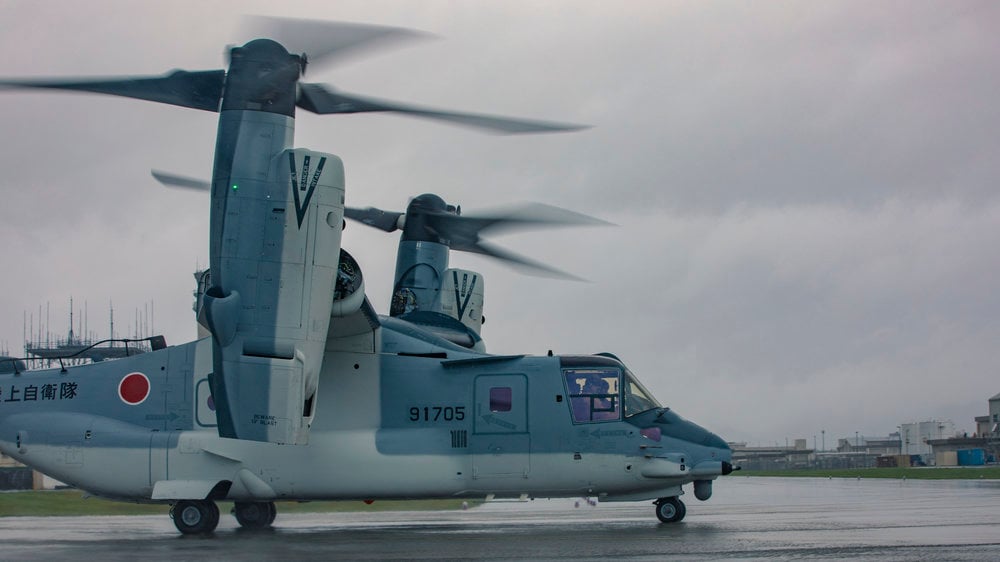
Japan’s fleet of MV-22B Ospreys are set to resume flights as early as Friday, according to the mayor of Kisarazu City, where much of the Japan Ground Self-Defense Force is based. However, both Japan Defense Minister Minoru Kihara and the Ministry of Defense have said the fleet’s first flight since the grounding will depend on weather conditions and other factors.
On Tuesday, the Kisarazu City Council posted a notification on the resumption of operations by JGSDF Ospreys at JGSDF Camp Kisarazu, which is located on the main island of Honshu. Japanese city councils routinely post notifications of Japan Self-Defense Force and U.S. military activities in the vicinity of the city. The MoD usually holds direct meetings to provide explanations to the city councils when operations are likely to cause concern among city residents, such as flight operations, particularly those involving the Ospreys.
Kisarazu City Mayor Yoshikuni Watanabe said in the notification that the city approved the resumption of Osprey flights after receiving a briefing on the root causes of the fatal accident in November that killed eight U.S. airmen. City officials were also briefed on the safety measures put in place to reduce the risk of flight.
“Kisarazu City approved the resumption of operations of the Ground Self-Defense Force Osprey and once again called for ensuring the safe flight of the Ground Self-Defense Force Osprey,” Watanabe said. The city mayor also said the Osprey would begin flights staring on Friday. The city will closely monitor the operations of JGSDF Ospreys and other Japanese military aircraft and will work to “ensure that there is no cause for concern among citizens.”
“In any case, we would like to resume operations in due course after carefully explaining the situation to the local governments concerned,” Defense Minister Kihara said on Tuesday when asked about the mayor’s announcement.
Earlier that morning, Kihara said JGSDF Osprey flights would only resume after confirming an individual aircraft’s flight safety. Kihara said that of the JGSDF’s 14 Ospreys, 12 are currently at JGSDF Camp Kisarazu, while one is at JGSDF Camp Metabaru and another is at JGSDF Vice-Camp Takayubaru. The latter two bases are on the main island of Kyushu.
Japan-based U.S. Marine Corps Ospreys of the 1st Marine Air Wing returned to flight status on March 14, the Marine Corps announced.
“We will thoughtfully regain currency of our pilots and aircrew as we return to MV-22 flight operations,” sMaj. Gen. Eric Austin, the commanding general of the 1st MAW, said in the news release. “The MV-22 Osprey is key to the success of 1st MAW, III MEF and plays a central role in our ability to campaign, to respond in time of crisis and ultimately to partner with our allies and maintain a free and open Indo-Pacific. We are pleased to be flying our MV-22s again.”
The 1st MAW’s Hawaii-based Osprey squadrons of Marine Aircraft Group 24 are expected to resume flight operations this week, according to a Marine Corps news release issued Friday.
“The MV-22 squadrons will adhere to the Marine Corps’ three-phased approach, which begins with a focus on regaining proficiency in Core and Basic skills for pilots and aircrew,” the statement reads.
“Squadrons will then follow well-established training and readiness manuals, standard operating procedures, and best practices to demonstrate the skills reinforced in phase one,” it continues. “Upon completion of the first two phases of skill development and demonstration, squadrons will progress toward conducting specific pre-deployment training programs – to include flight operations in the local area – in preparation for their next assigned missions.”
On Friday, the Marine Corps also announced that the 26th Marine Expeditionary Unit’s Ospreys would be cleared to fly starting March 17.
“Throughout our deployment across the Tri-COCOM area of operations, the versatility, reach, and operational flexibility provided by having four of our MV-22s on the LPD [USS Mesa Verde] and eight MV-22s on the LHD [USS Bataan] have been essential to our overall success as a naval expeditionary crisis response force within both U.S. 6th Fleet and U.S. 5th Fleet areas of operations,” Col. Dennis Sampson, the commanding officer of the 26th MEU, said in a news release.
USNI News reported in December that the embarked 26th MEU Ospreys with the Bataan Amphibious Ready Group had been given special permission to operate the grounded Ospreys in case of emergencies, though there has been no indication that the unit exercised the waiver during its deployment. The ARG and MEU began returning home on Saturday following an eight-month deployment, reported USNI News.





